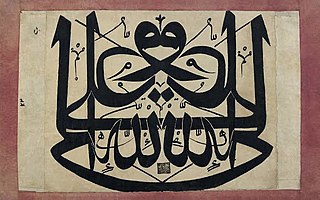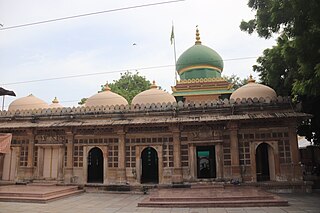
Hashim peer Dastagir [1] was an Indian Sufi saint according to the tradition of the Qadri Shattari Sufi order. [2] His shrine is in Bijapur, Karnataka, India. [3]

Hashim peer Dastagir [1] was an Indian Sufi saint according to the tradition of the Qadri Shattari Sufi order. [2] His shrine is in Bijapur, Karnataka, India. [3]
| Part of a series on Islam Sufism |
|---|
 |
Hashim Peer Dastagir (Arabic: هاشم پیر دستگیر, romanized: Hashim Pir Dastgir) was born in 1576 in Ahmedabad, Gujarat. [4] He was brought up in a scholastic atmosphere under the particular influence of Sayyedina Wajihuddin Alvi. [2]
Muhammad Ghawth gave his khilafat to Wajihuddin Alvi. Later, the khilafat passed to his nephew Hashim peer Dastagir.
Hashim peer went to Bijapur, Karnataka, [2] then under the rule of Ibrahim Adil Shah II. [2] Under his influence Ibrahim Adil Shah then gave up un-Islamic practises. The next Sultan Mohammed Adil Shah was his disciple. [4] When the Sultan was suffering from a serious disease, Hashim peer stated that he is granting to his disciple ten years of his life. As a consequence, the Sultan built the monument of Gol Gumbaz, which is located near the shrine of Hashim peer. [5]

His shrine is in Bijapur. [3] the shrine of Hashim peer Dastagir is a symbol of communal harmony, since it attracts the crowds from all religious faiths . [4] The shrine was built by Mohammad Adil Shah in 1649. [4] Every year, thousands of devotees attend the annual Urs celebration of Hashim peer Dastagir. [4] Sayed Shah Murtuza Husaini Hashimi is the chief of the shrine and a descendant of Hashim Peer Dastagir. [4]
Successors of Hashim Peer Dastagir include Haji Wajihuddin Gujrati Alwi Qadri Shattari. Later, the succession passed to Sufi Sarmast Ali Shah Qalandar. His shrine is located in Nandura, Maharashtra. [6] Maulana Muhammad Siddiq was his successor. Succession passed to Muhammad Ghani Qadri Shattari and subsequently to Muhammad Wali Qadri Shattari. Muhammad Ghani's shrine is located in Sufi Nagar Kondhali in Maharashtra. [7] [8] It is said that Mushtaque Husain Qadri Shattari is one of the current figurehead of this order. [6]

Sultan-ul-Mashaikh, Mahbub-e-Ilahi, Sheikh Khwaja Sayyed Muhammad Nizamuddin Auliya, also known as Hazrat Nizamuddin, and Mahbub-e-Ilahi was an Indian Sunni Muslim scholar, Sufi saint of the Chishti Order, and is one of the most famous Sufis from the Indian Subcontinent. His predecessors were Fariduddin Ganjshakar, Qutbuddin Bakhtiyar Kaki, and Moinuddin Chishti, who were the masters of the Chishti spiritual chain or silsila in the Indian subcontinent.

The Adil Shahi or Adilshahi, was a Shia, and later Sunni Muslim, dynasty founded by Yusuf Adil Shah, that ruled the Sultanate of Bijapur, centred on present-day Bijapur district, Karnataka in India, in the Western area of the Deccan region of Southern India from 1489 to 1686. Bijapur had been a province of the Bahmani Sultanate (1347–1518), before its political decline in the last quarter of the 15th century and eventual break-up in 1518. The Bijapur Sultanate was absorbed into the Mughal Empire on 12 September 1686, after its conquest by the Emperor Aurangzeb.

The Qadiriyya are members of the Sunni Qadiri tariqa. The tariqa got its name from Abdul Qadir Gilani, who was a Hanbali scholar from Gilan, Iran. The order relies strongly upon adherence to the fundamentals of Sunni Islamic law.

Jalāl Mujarrad Kunyāʾī, popularly known as Shah Jalal, was a celebrated Sufi figure of Bengal. His name is often associated with the Conquest of Sylhet and the Spread of Islam into the region, part of a long history of interactions between the Middle East, Central Asia, and South Asia. Various complexes and religious places have been named after him, including the largest airport in Bangladesh, Hazrat Shahjalal International Airport.

Sharafuddeen Bu Ali Shah Qalandar Panipati, renowned as Bu Ali Qalandar, born in Panipat, Haryana, India, was a Qalandar and Sufi saint of the Owaisī Order, who lived and taught in India. His shrine or dargah (mausoleum) is at Bu Ali Shah Qalandar Dargah, Panipat, which is a place of pilgrimage.
Muhammad GhawthGwaliyari (1500–1562) was a 16th-century Sufi master of the Shattari order and Sufi saint, a musician, and the author of Jawahir-i Khams. The book mentioning the life and miracles of Gaus named " Heaven's witness" was written by Kugle.

Syed Shah Jamal Uddin Naqvi Bukhari also known as Baba Shah Jamal was a Sufi saint. He is also known as Hussaini Syed.

Sheikh Noor ul Mashaikh Sayyid Ahamed Muhyudheen NooriShah Jeelani Arabic:, known more commonly as NooriShah Jeelani, was a renowned 20th-century muslim, sufi, wali, mystic, orator, faqeeh, theologian, mujaddid and highly acclaimed Islamic scholar of the Qadri, Chisti order from the Indian sub continent. He was the 21st grand son of the famous Sufi saint Ghous-e-Azam Sheikh Mohiyudheen Abdul Qadir Jilani of Baghdad. He was also widely known by his title Noor-ul-Mashaikh. He was the Eponymous founder of the Silsila-e-Nooriya tariqa which is a sub-branch of Qadiriyya and Chistiyya in India.

The Shattari or Shattariyya are members of a Sufi mystical tariqah that originated in Persia in the fifteenth century C.E. and developed, completed and codified in India. Later secondary branches were taken to Hejaz and Indonesia. The word Shattar, which means "lightning-quick", "speed", "rapidity", or "fast-goer" shows a system of spiritual practices that lead to a state of "completion", but the name derives from its founder, Sheikh Sirajuddin Abdullah Shattar.

Hazrat Mawlana Pir Fazal Ali Shah Qureshi was an Islamic scholar and the leading Naqshbandi Shaikh of colonial India in the early twentieth century. He was born to Murad Ali Shah in 1270 AH in Daud Khel, Punjab, and died at 84 in the first night of Ramadan 1354 AH and was buried at Miskeenpur shareef, district Muzaffargarh, Punjab.
Shah Deccan Qutub Kokan Khwaja Pir Hafiz Habib Ali Shah was born in a Sufi family, whose lineage is traced back to Abu Bakr, the first Caliph of Islam, his ancestors were Sufi masters. From Syedna Abu Bakr Siddiq, the forefathers of Pir Khaja Habib Ali Shah حضرت حبئب علی شاہ obtained the spiritual education (Tassawuf/Tariqat) and bestowed with Caliphat from their fathers

Syed Baba Fakhr al-Din Hassaini ul Hussaini commonly known as Baba Fakhruddin was a Persian Sufi of Suhrawardiyya order from present-day Eastern Iran.

Shah Wajihuddin Alvi Gujarati, also known the epithet Haider Ali Saani, was an Islamic scholar and Sufi in the Shattari tradition.

Wajihuddin's Tomb or Hazrat Wajihuddin Dargah, is a tomb of Sufi saint Wajihuddin Alvi in Khanpur area of Ahmedabad, India.

Sayed Tanveer Hashmi, also known as Tanveer Hashmi, is a Sufi leader and spiritual master From Bijapur Sharif, a Sufi shrine in Karnataka, India. Tanveer Hashmi is a patron of various academic, social, and other activities of Sufi Sunni Muslims in India. He belong to Hussiani Hashmi Family, the family of Ahle Bait. His official name in Shajra Shareef is Syed Mohiuddin Hussaini Hashmi Al-Qadri.

Syed Najmuddin Ghawsud Dahar Qalandar well known as Qutub ul Aqtaab was a Qalandar and Sunni Muslim scholar, Sufi saint of the Chishti Order, and one of the most famous Sufis on the Indian subcontinent who lived and taught in India. He traced his lineage to Muhammad through Imam Hussain. Hazrat Nizamuddin gaznavi made him his Mureed, he later asked him to get the faiz from Hazrat Shah Khizr Rumi who gave him the title “Ghawsud Dahar”, he made him his Khalifa, after receiving khilafat from him he went to Arab, Ajam, China and India then he finally settled in Malwa region in. His shrine or Dargah (mausoleum) is at Nazmuddin Qalandar Dargah in the city of Nalchha, Dhar which is a place of Pilgrimage and visited millions of devotees every year.
ʿAli Shīr al-Ḥanafī al-Bangālī, or simply Ali Sher Bengali, was a 16th-century Bengali author, teacher and Sufi pir of the Shattari order. He was one of the three khalifahs (successors) of Muhammad Ghawth Shattari.

Mufti Yūsuf Bangālī was a 16th-century Sufi pir of the Shattari order. He was a prominent teacher during the reign of the Farooqui dynasty and Mughal emperor Akbar.
The Qadri Shattari Sufi order is Shattariyah branch of Qadri Sufi order followed in India and Pakistan. According to political scientist Ishtiaq Ahmed, the Qadri Shattari sufi tradition sought synthesis between Hindu and Muslim mysticism and focus on the concept of Waḥdat al-wujūd.
{{cite web}}: CS1 maint: url-status (link){{cite web}}: CS1 maint: url-status (link)